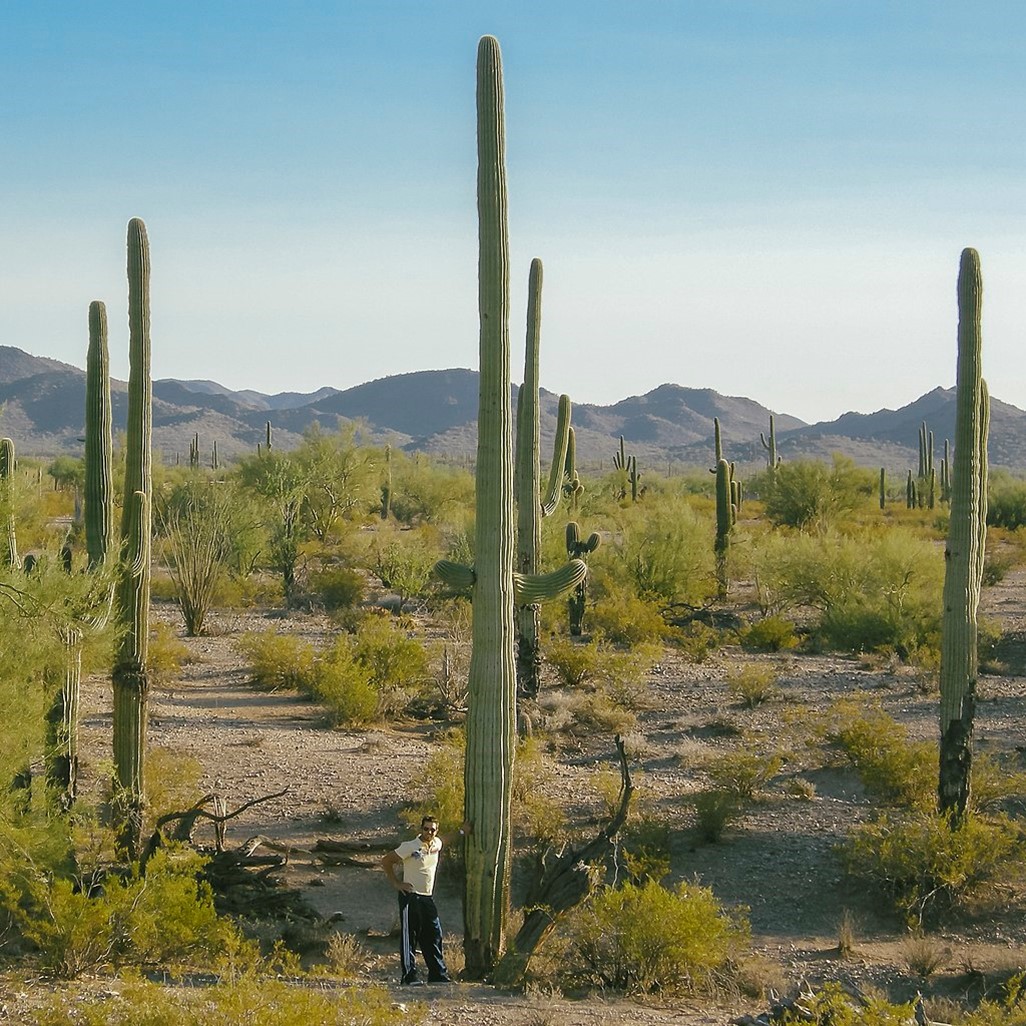
Credit: Matthew T Rader, via Wikimedia Commons
Cacti are native to the Americas and first evolved 30 million years ago—which sounds like a long time—but they’re hundreds of millions of years younger than most other types of plants.
They’re specially adapted to dry environments, having transformed their trunks into thick, green, water-storing tissue and their leaves into spines.
Cacti grow from half an inch to more than 60 feet in height and range from Patagonia to Canada.
They draw in CO2 at night to fuel photosynthesis during the day, then close their pores as temperatures rise to avoid evaporation.
Perhaps the most iconic cactus is the giant saguaro. It’s become a symbol of the American West but grows mainly in Arizona. And very slowly.
It takes 10 years to reach an inch tall. Seventy to reach six feet. By the time it’s 200, it has reached its full height of 40 plus feet.
Along with a tap root to hold it up, saguaros, like most cacti, have a broad shallow root system, just a few inches below the surface. An adult saguaro can use this to suck up 200 gallons of water during a single desert rain storm.
That might make them sound like a good water source, but cacti produce acids and alkaloids to protect themselves; drinking their stored water can make you sick.
The fruits of all cacti, however, are edible. But most are prickly, and many taste bad. The cactus has evolved to be as tough as its environment.
Background
Synopsis: Iconic cacti are only native to the Americas, with one possible exception. Cactus species evolved to survive arid conditions by modifying their leaves, branches, stems and root systems, and by changing the way their photosynthesis works to defy dehydration.
- There are more than 1,750 species of the cactus family Cactaceae that are native to the Americas ranging from 1/2 inch (1 cm) to more than 60 ft (19 m) tall. Only one wild species of cactus is found outside of the Americas.
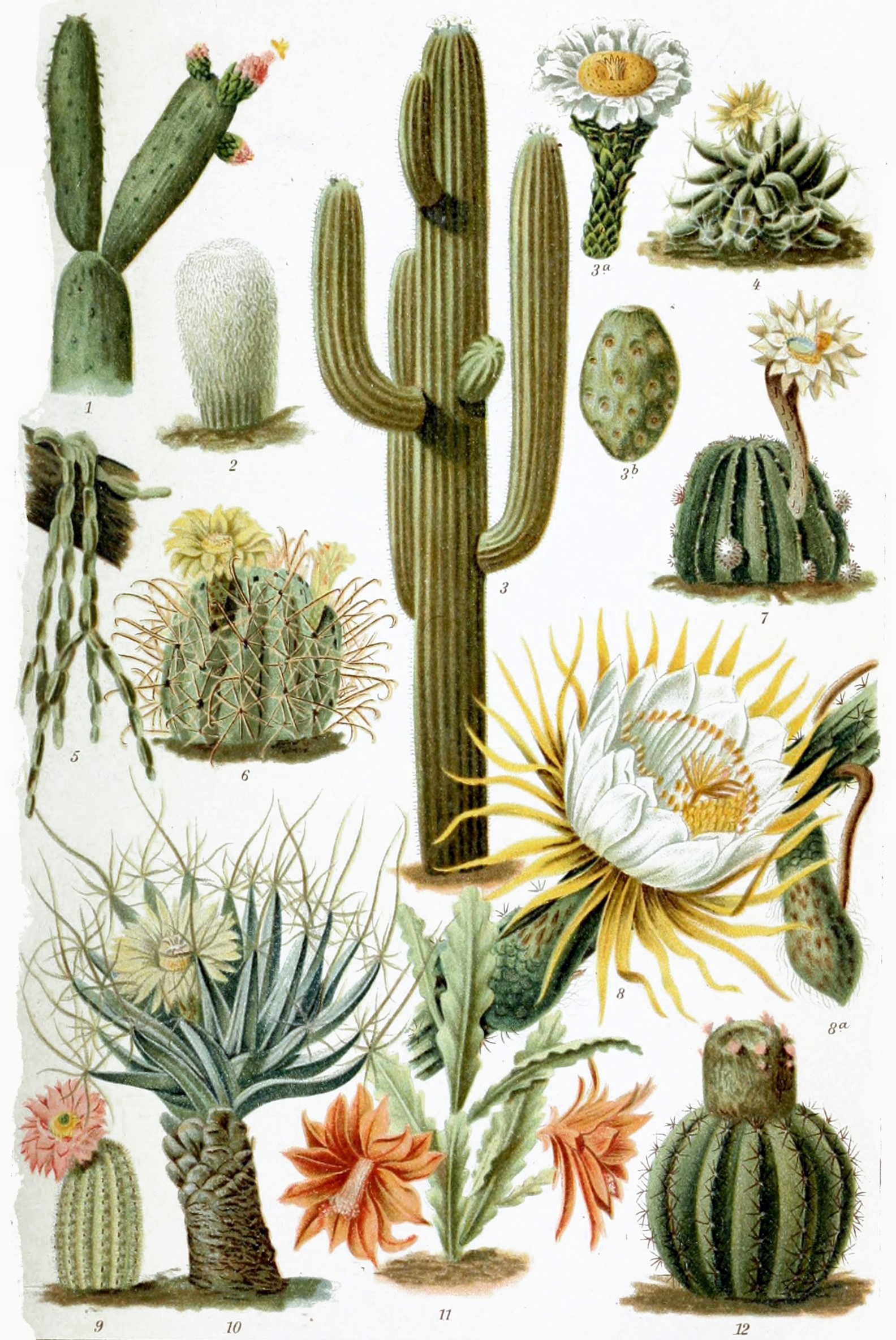
Illustrations of various members of the Cactaceae family: 1-Nopalea coccinellifera; 2-Cephalocereus senilis; 3-Cereus giganteus; 4-Mammillaria longimamma; 5-Rhipsalis paradoxa; 6-Echinocactus longihamatus; 7-Echinopsis oxygona; 8-Cereus grandiflorus; 9-Echinocereus pectinatus; 10-Leuchtenbergia principis; 11-Phyllocactus ackermanni; and 12-Melocactus communis.
Credit: G. Mütrel, Leipzig ; Berlin ; Wien : F.A. Brockhaus, public domain, via Wikimedia Commons- Cacti are xerophytes, meaning they have adapted to survive in environments with little to no liquid water. Drought stress is a key selective pressure for plants.
- Species of the Cactaceae family can be found in the Americas from 49° south latitude in the Patagonian region of Chile and Argentina to 57° north latitude near Peace River in the Canadian province of Alberta.
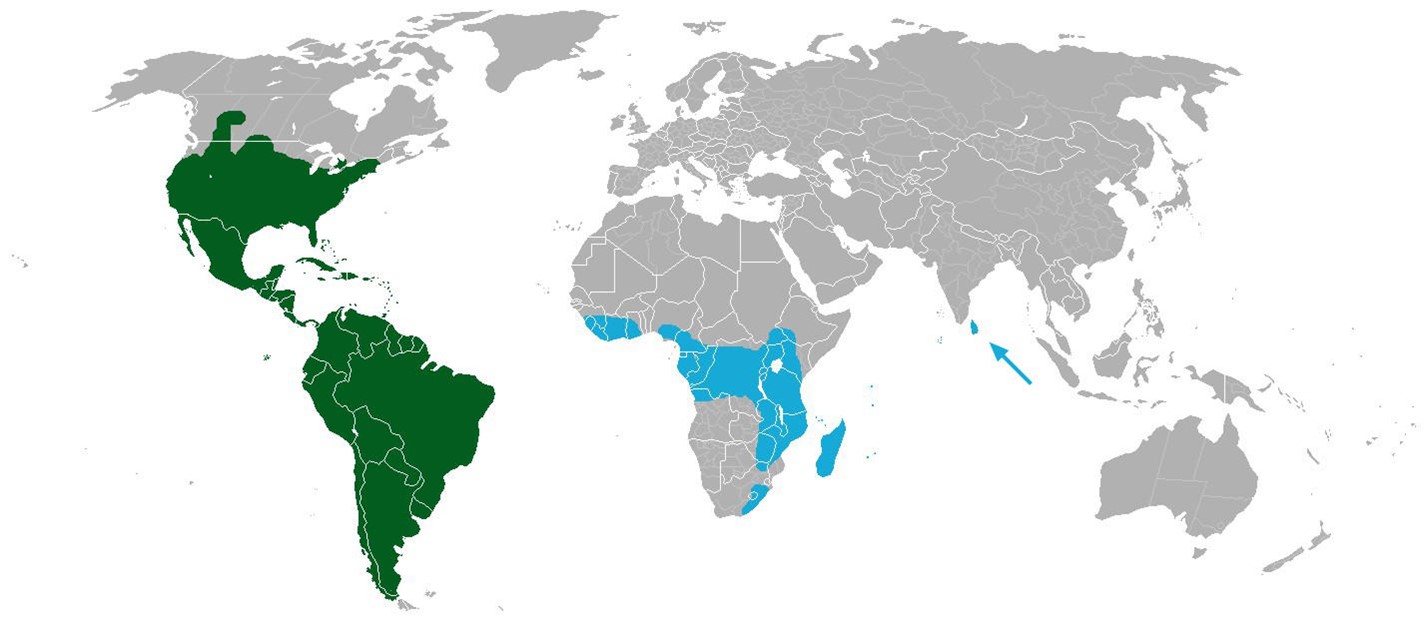
Global distribution of all cactus species in green and distribution of a single species, Rhipsalis baccifera in blue.
Credit: Cactaceae_distrib_kz.jpg: Kenraiz, Krzysztof Ziarnekderivative work: Peter coxhead, via Wikimedia Commons - The spaghetti or mistletoe cactus (Rhipsalis baccifera) of India, Sri Lanka and Africa also occurs in the Americas and may have been distributed by birds or sailors. It is an epiphyte (air plant) that draws its moisture from the air.
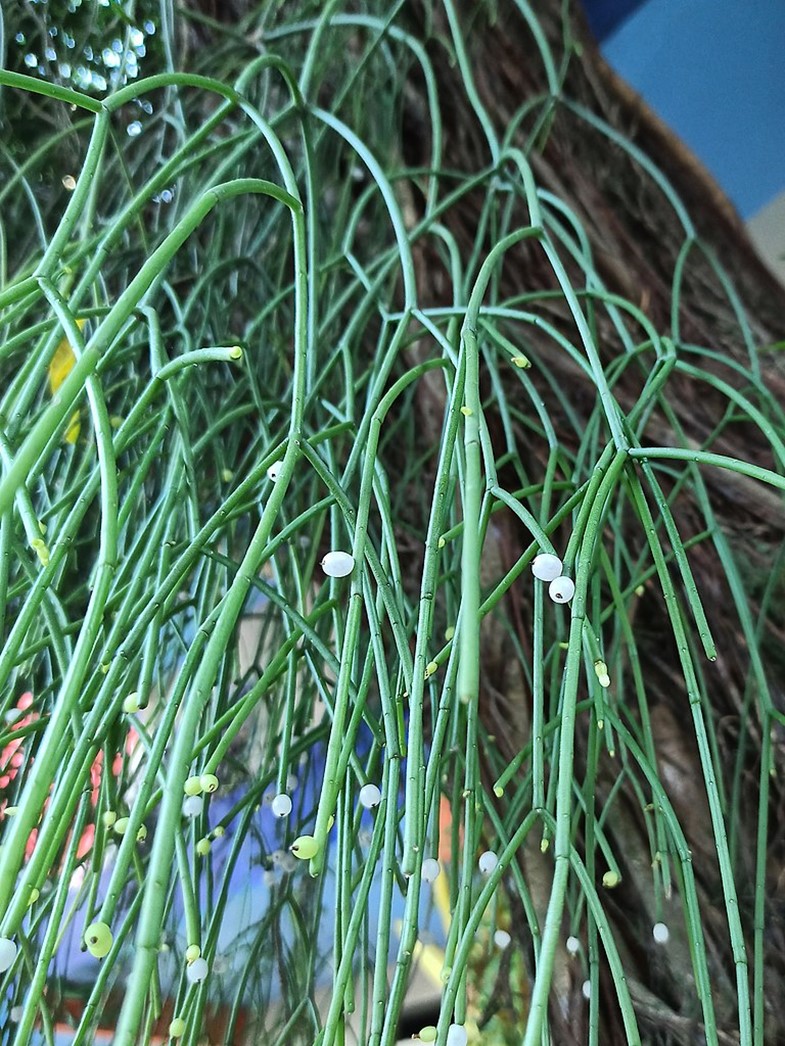
Rhipsalis baccifera is also known as mistletoe cactus because of its white berries. It is the only cactus with a native range that extends beyond the Americas to India, Sri Lanka and Africa.
Credit: Juan Carlos Fonseca Mata, via Wikimedia Commons - Members of the cactus family live in ecosystems ranging from desert to tropical and from sea level to more than 4,000 ft (1,220 m) elevation.
- Cacti specialize in niches prone to drought because they adapted every typical plant feature—leaves, branches, stems and roots—to conserve water.
- Leaves in most plants are temporary sunlight-collecting photosynthetic factories, but their large surface area is prone to water loss. Cactus leaves evolved into nonphotosynthetic spines that protect the plant from herbivores and limit air flow around the stem to minimize evaporation.
- Branches became greatly reduced into flat aureoles where both spines and flowers emerge from the stem (just like branches protrude from typical plant stems to carry their leaves and flowers). Aureoles are the distinctive trait that separates a true cactus from similar succulents.

A distinctive feature of a cactus is the aureole, which is a modified branch. Spines that grow out of the aureoles are adapted from leaves. Flowers also emerge from aureoles along the green water-engorged stem of the cactus. The stem is where a unique highly efficient type of photosynthesis occurs in cacti.
Left Credit: John Tann from Sydney, Australia, via Wikimedia Commons
Right Credit: Mike Kirby / Cactus 4a, Wikimedia Commons - The chlorophyll green cactus stem assumed the photosynthetic energy producing role and evolved large mucilaginous cells that swell to store water inside an evaporation resistant waxy skin that is typically ribbed to enable rapid expansion. Many cacti are globe shaped, to retain the highest volume of water for the lowest exposed surface area. Adult saguaros can absorb around 200 gallons (750 l) of water during a single rain event.
- Succulents adapted photosynthesis to work in arid environments through crassulacean acid metabolism (CAM), which enables the plant to collect CO2 at night and store it as malic acid (C4H6O5), until daylight begins the photosynthetic process. Stomates are closed during the heat of the day to avoid transpiration of water. This process uses both CO2 and water very efficiently compared to other plants.

Schematics of CAM photosynthesis. Night (left): stomata open; CO2 enters and is stored as malic acid; water vapor is able to escape. Day (right): stomata close; malic acid is converted back to CO2 and used to make carbohydrate; water vapor is confined.
Credit: Peter Coxhead, public domain, via Wikimedia Commons - Root systems evolved into shallow fibrous systems that spread over a large area within about 3 in of the surface to rapidly absorb limited rainfall. Some tall cacti have deep taproots for structural support.
- At the extreme end of adaptations, tropical cactus species used these desert modifications to occupy soilless, hot, and dry forest canopy niches as epiphytes, or air plants, by drawing moisture directly from humid air.
- Individual cactus plants grow very slowly and may even become dormant.
- It may take 70 years for the largest species of cactus—a saguaro—to grow as tall as a man and produce its first flowers.
- A saguaro cactus won’t grow arms until they are nearly 100 years old years old, but, after that, they may grow up to 25 arms, or they may remain armless.
- They typically grow to 40 ft (12 m), and they live for 200 or more years.
- The largest saguaro ever measured was an armless saguaro that was 78 ft (24 m) tall before it blew down in a windstorm in 1986.
- Some may look like other trees but have areoles that identify them as cacti.
- While an individual cactus may grow very slowly with a long time between generations, the diversification of cacti species happened very rapidly, probably in response to tectonic activity that drove ecological stimuli.
- Like other plant species from desert settings, there is no fossil record for the Cactaceae family but using data from DNA and proteins (phylogeny), researchers estimate that cactus first evolved in Mexico or South America around 32 million years ago, at the start of the Oligocene Epoch.
- Major diversification of cacti occurred very rapidly 5 to 10 million years ago as arid regions expanded in the Americas in response to the uplift of the Andes Mountains in the late Miocene.
- While a large cactus may absorb a lot of water, be careful using them as a water source, as they protect themselves with both alkaloids and acids, which can make you sick.
- The fruits of all true cacti are edible, but some may need special preparation and others are not very tasty.
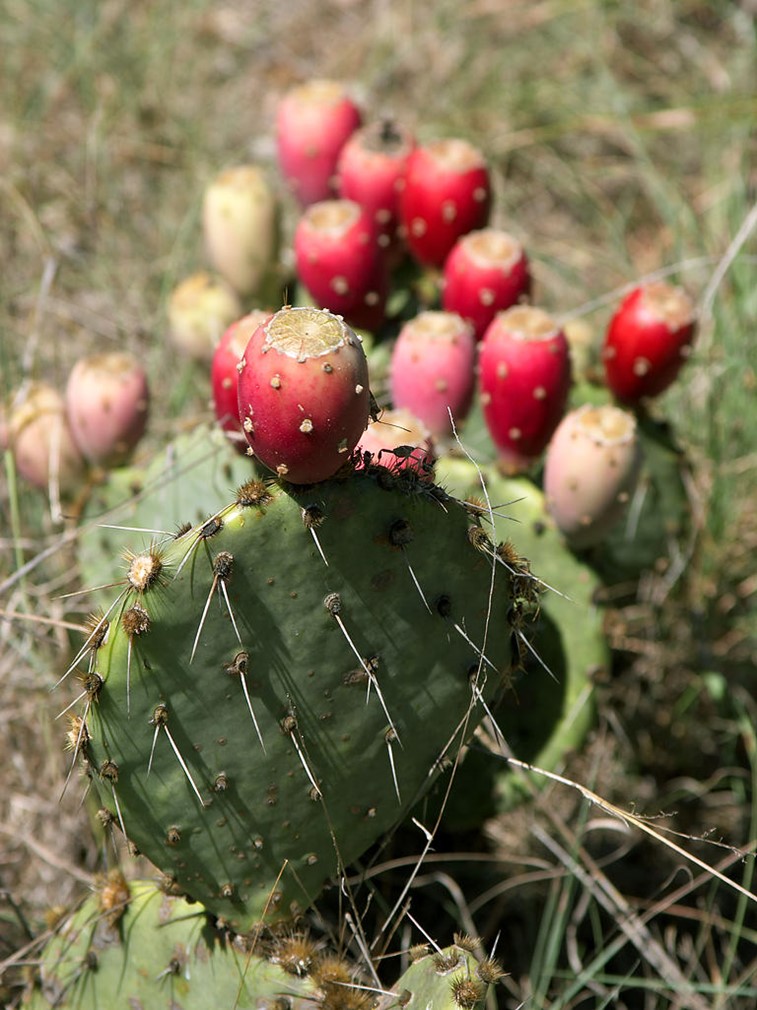
Prickly pears (Opuntia) are one of the best-known edible cacti. The fruit is called a tuna and is peeled before using in jams, sweets and beverages. The paddles of the cactus are stems with additional modification and are called nopales.
Credit: Cactus.man, public domain, via Wikimedia Commons
Mexican nopal salad with cleaned and cooked strips of pads from the prickly pear cactus. They taste like a cross between green beans and asparagus.
Credit: jlastras, via Wikimedia Commons
- The fruits of all true cacti are edible, but some may need special preparation and others are not very tasty.

